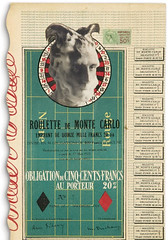
PREV ARTICLE
NEXT ARTICLE
FULL ISSUE
PREV FULL ISSUE
MARCEL DUCHAMP'S MONTE CARLO BOND NO 1
Regular readers know I have an interest in the intersection of numismatics and art, such as the work of "money artist" J.S.G. Boggs. So I was interested to learn in last week's Coin World about the sale of a "bond" created by artist Marcel Duchamp. The item wasn't pictured, so I was curious. Below is part of the lot description from Christies' November 10, 2010 New York auction (Sale 2355, Lot 9). The item sold for $1,082,500!
-Editor
Duchamp decided to expand upon its principles and profits by simply increasing the amounts of money wagered. In order to raise the funds required to finance a more ambitiously conceived operation, he planned to issue stocks in his new company - thirty shares at an assigned value of 500 francs each - repayable to investors at the rate of 20 interest over the course of a three-year period. Ownership in the company would be established by the purchase of a bond, a legal document that Duchamp himself carefully designed and issued. The bond features a diagrammatic, overhead view of a roulette table, crowned at the summit by a photo-collaged portrait of Duchamp by Man Ray. Duchamp's features in this photograph are barely discernable; his head is completely enveloped in layers of shaving lather, his hair peaked into two devilish horns, intended, perhaps, as a commentary on the diabolic nature of his enterprise. As these various items were designed with humorous intent, there is little doubt that Monte Carlo Bond was intended to elicit a like response, although we now know that - for Duchamp and his potential investors - it was also to be understood as a bona fide legal document. Once he had determined the final appearance of the bond, he arranged for it to be printed and made available for purchase. Years after his gambling scheme failed, Duchamp admitted to an interviewer that the gambling scheme he devised was ineffective: he won nothing (quoted in Salt Seller, p. 137). "The system was too slow to have any practical value," he told an audience a few years before his death, "sometimes having to wait a half hour for the propitious figure to appear in the succession of blacks and reds. And the few weeks I spent in Monte Carlo were so boring that I soon gave up, fortunately breaking even"
To view the lot description, see:
Monte Carlo Bond (No. 1)
(www.christies.com/LotFinder/lot_details.aspx? The Numismatic Bibliomania Society is a non-profit organization promoting numismatic literature. See our web site at coinbooks.org. To submit items for publication in The E-Sylum, write to the Editor at this address: whomren@gmail.com To subscribe go to: https://my.binhost.com/lists/listinfo/esylum All Rights Reserved. NBS Home Page Contact the NBS webmaster 
|
